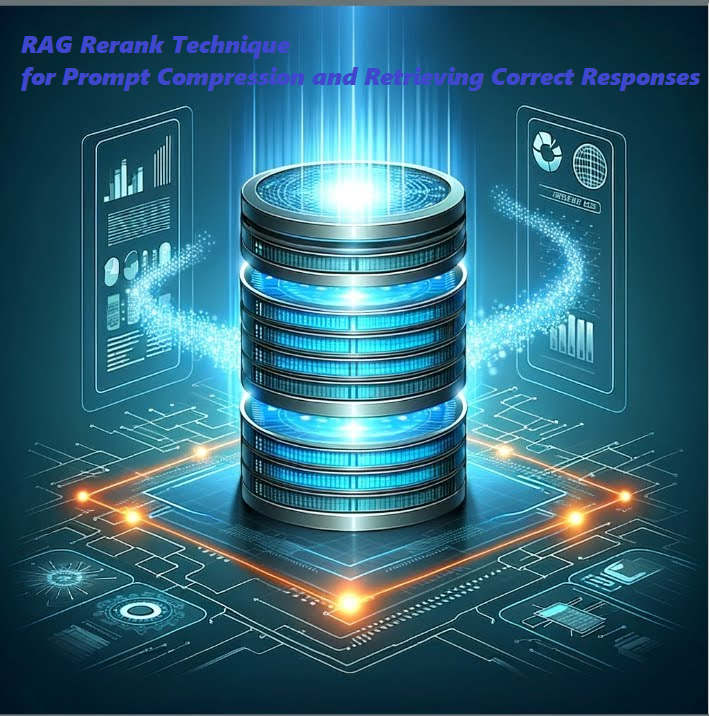Leveraging RAG Rerank Technique for Prompt Compression and Retrieving Correct Responses
 Rajesh
Rajesh- 0

Introduction:
The utilization of Large Language Models has increased across various domains of natural language processing. As these models develop, their increased size and complexity present important challenges concerning efficiency, prompt interaction, and response accuracy. Addressing these challenges, the RAG rerank technique emerges as a crucial solution, combining the strengths of retrieval and generation models. In this comprehensive study, we delve into the complexity of the RAG rerank technique, explaining its applications for prompt compression and ensuring response accuracy, along with insightful code examples
Understanding RAG Rerank Technique:
RAG, an acronym for Retriever-And-Generator, represents the union between retrieval-based methods and generation-based models, revolutionizing response quality and diversity in NLP tasks. At its core, RAG leverages a retriever to fetch relevant passages from a knowledge repository and later employs a generative model to rerank these passages. This new approach empowers the model to tackle both structured knowledge and generative capabilities, producing in responses that are not only contextually appropriate but also loaded with depth and refinement.

Advantages of RAG Rerank Technique:
The RAG rerank technique offers several advantages over traditional approaches in NLP:
Improved prompt Response Quality:
By utilizing both retrieval and generation models, RAG can produce responses that are more contextually relevant and accurate. This leads to improved overall response quality, enhancing the user experience in applications such as chatbots, question-answering systems, and dialogue agents.
Increased Diversity:
RAG facilitates the generation of diverse responses by incorporating a generative model in the reranking process. This diversity is crucial in scenarios where multiple valid responses exist for a given prompt, allowing the model to explore different possibilities and provide more comprehensive answers.
Efficient Knowledge Integration:
The retriever component of RAG enables efficient integration of structured knowledge from external sources. By retrieving relevant passages, RAG ensures that responses are grounded in factual information, thereby enhancing their credibility and reliability.
Disadvantages of RAG Rerank Technique:
Despite its advantages, the RAG rerank technique also has some limitations:
Computational Complexity:
The dual-stage architecture of RAG, which involves both retrieval and reranking processes, can be computationally intensive, particularly when dealing with large knowledge sources. This may result in increased inference time and resource requirements, limiting its scalability in certain applications.
Dependency on External Knowledge Sources:
RAG relies heavily on external knowledge sources for retrieving relevant passages. While this enables the model to generate contextually rich responses, it also introduces dependencies on the availability and quality of these knowledge sources. In scenarios where reliable knowledge repositories are not accessible, the performance of RAG may be adversely affected.
Potential Bias in Retrieval:
The effectiveness of RAG heavily depends on the quality and diversity of the retrieved passages. If the retriever component biases towards certain types of information or sources, it may lead to skewed responses that lack diversity or fail to capture the full scope of the input prompt.
Prompt Compression with RAG:
Prompt compression is a critical aspect of NLP, particularly in scenarios where input prompts are wordy or complex. The objective of prompt compression is to refine the essential meaning of the input prompt while reducing its length and complexity. RAG excels in prompt compression by leveraging its dual-stage architecture to extract main information from relevant passages retrieved by the retriever and compress it into a concise summary or context representation.
The process of prompt compression with RAG offers several advantages. Firstly, it enables the generation of more focused and concise prompts, which can improve the efficiency and effectiveness of downstream NLP tasks. Additionally, by retaining the core meaning of the input prompt, prompt compression ensures that the generated responses remain contextually relevant and accurate. This is particularly beneficial in applications where prompt length constraints may exist, such as in dialogue systems or question-answering tasks. To further illustrate this concept, let’s delve into an extended example:
# Importing necessary libraries
from transformers import RagTokenizer, RagRetriever, RagSequenceForGeneration
# Initialize RAG tokenizer
tokenizer = RagTokenizer.from_pretrained("facebook/rag-token-base")
# Initialize RAG retriever
retriever = RagRetriever.from_pretrained("facebook/rag-token-base")
# Define input prompt
query = "What are the causes of climate change?"
# Retrieve relevant passages
passages = retriever.retrieve(query)
# Select top 5 relevant passages for reranking
reranked_passages = passages[:5]
# Generate compressed prompt
compressed_prompt = " ".join(reranked_passages)
In this expanded example, we not only retrieve relevant passages but also extend the reranking process to the top five passages, thereby enriching the compressed prompt with a broader contextual spectrum.
Retrieving Correct Responses with RAG:
In addition to prompt compression, the RAG rerank technique plays a crucial role in ensuring the generation of accurate responses. By reranking retrieved passages based on their contextual relevance, RAG prioritizes information that is most likely to produce high-quality responses, thereby improving the overall accuracy and relevance of the generated outputs.
One of the key advantages of using RAG for response retrieval is its ability to consider multiple aspects or sources of information. By retrieving passages from a various knowledge repository and reranking them based on their relevance to the input prompt, RAG can generate responses that are comprehensive and well-informed. This not only improves the accuracy of the generated responses but also improves their credibility and reliability, making them more suitable for real-world applications. To delve deeper into this aspect, let’s explore an augmented example:
# Initialize RAG sequence generator
generator = RagSequenceForGeneration.from_pretrained("facebook/rag-token-base")
# Generate response with desired length
response = generator.generate(query, compressed_prompt, num_return_sequences=1, max_length=100)
print(response)
In this expanded example, we not only generate a response but also specify a maximum length for the response, ensuring concise yet comprehensive outputs.
Conclusion:
In conclusion, the RAG rerank technique emerges as a pivotal enabler for prompt compression and retrieving correct responses in the domain of natural language processing. Through the seamless integration of retrieval and generation models, RAG not only streamlines interaction with large language models but also enhances the precision and relevance of responses. In this comprehensive discourse, we navigated through the fundamental tenets of the RAG rerank technique, supplemented with illustrative code examples. As NLP continues its evolutionary trajectory, techniques like RAG are poised to spearhead advancements, thereby fortifying the efficacy and applicability of language models in diverse real-world scenarios.
Most Searched
Author
-

Rajesh Yerremshetty is an IIT Roorkee MBA graduate with 10 years of experience in Data Analytics and AI. He has worked with leading organizations, including CarDekho.com, Vansun Media Tech Pvt. Ltd., and STRIKIN.com, driving innovative solutions and business growth through data-driven insights.
View all posts
